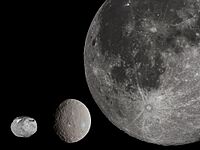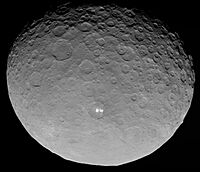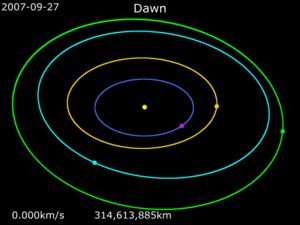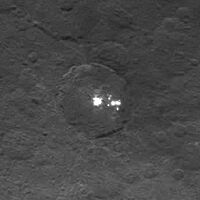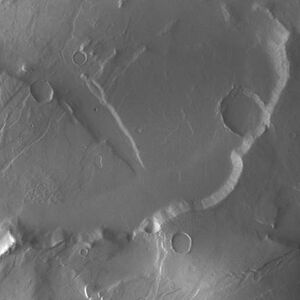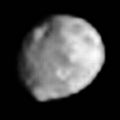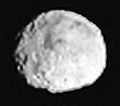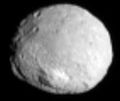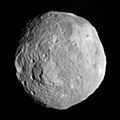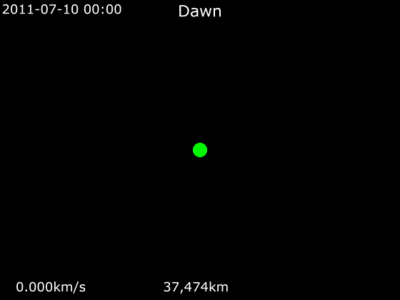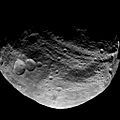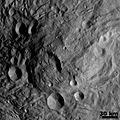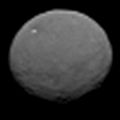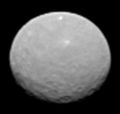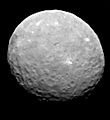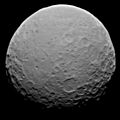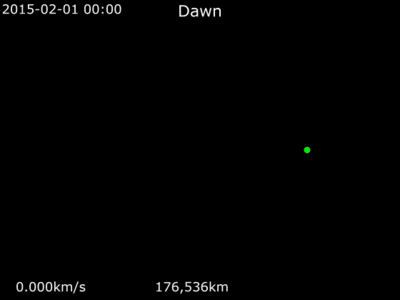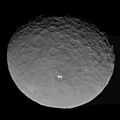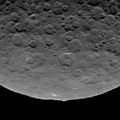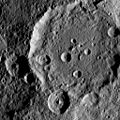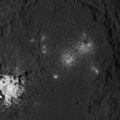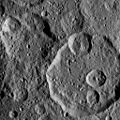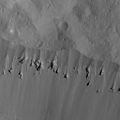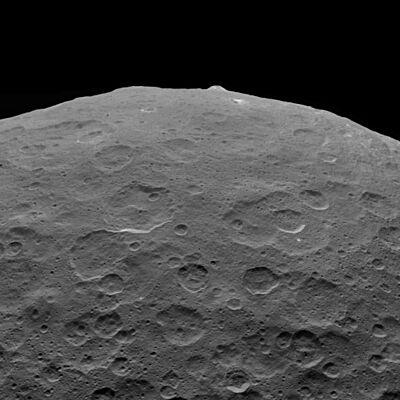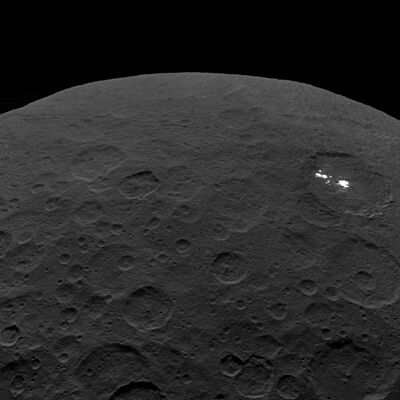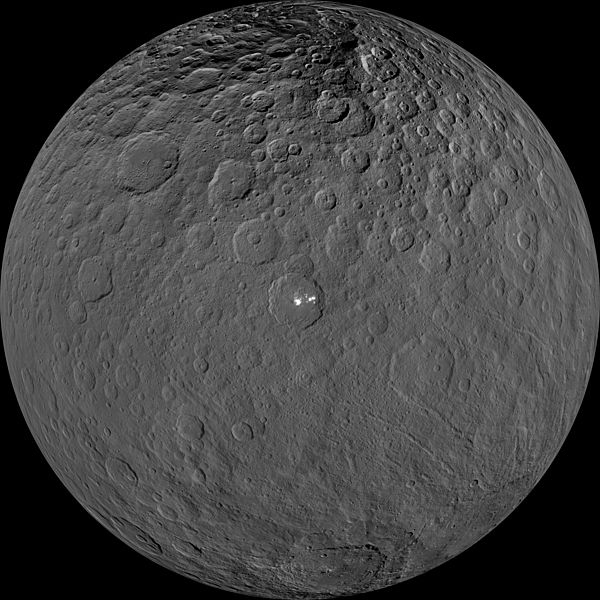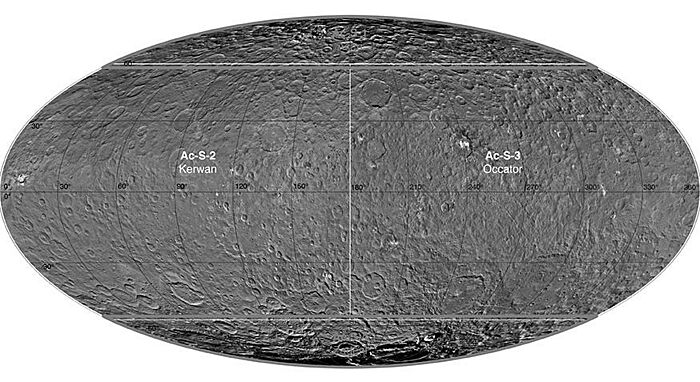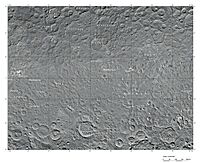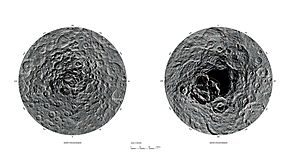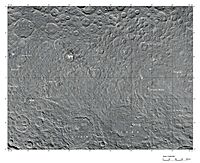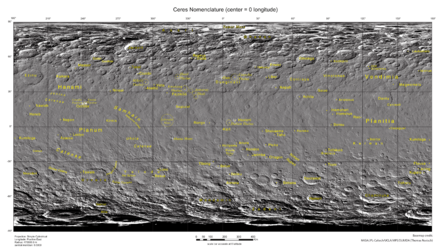Dawn (spacecraft) facts for kids
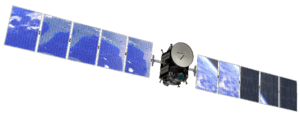
Illustration of the Dawn spacecraft
|
|
| Mission type | Vesta/Ceres orbiter |
|---|---|
| Operator | NASA / JPL |
| Website | science.nasa.gov |
| Mission duration | 11 years, 1 month and 5 days |
| Spacecraft properties | |
| Manufacturer | Orbital Sciences JPL UCLA |
| Launch mass | 1,217.7 kg (2,684.6 lb) |
| Dry mass | 747.1 kg (1,647.1 lb) |
| Dimensions | 1.64 × 19.7 × 1.77 m (5.4 × 65 × 5.8 ft) |
| Power | 10 kW at 1 AU 1.3 kW at 3 AU |
| Start of mission | |
| Launch date | September 27, 2007, 11:34 UTC |
| Rocket | Delta II 7925H D-327 |
| Launch site | Cape Canaveral SLC-17B |
| Contractor | United Launch Alliance |
| End of mission | |
| Disposal | Decommissioned |
| Last contact | October 30, 2018 |
| Decay date | ~2038 |
| Orbital parameters | |
| Reference system | Ceres |
| Regime | Highly elliptical |
| Semi-major axis | 2,475.1356 km (1,537.9780 mi) |
| Eccentricity | 0.7952 |
| Periapsis | 37.004 km (22.993 mi) |
| Apoapsis | 3,973.866 km (2,469.246 mi) |
| Inclination | 76.1042° |
| Period | 1,628.68 minutes |
| RAAN | −79.4891° |
| Argument of periapsis | 164.1014° |
| Epoch | October 30, 2018, 00:00:00 UTC |
| Flyby of Mars | |
| Closest approach | February 18, 2009, 00:27:58 UTC |
| Distance | 542 km (337 mi) |
| 4 Vesta orbiter | |
| Orbital insertion | July 16, 2011, 04:47 UTC |
| Orbital departure | September 5, 2012, 06:26 UTC |
| 1 Ceres orbiter | |
| Orbital insertion | March 6, 2015, 12:29 UTC |
 Dawn mission patch |
|
The Dawn spacecraft was a special probe launched by NASA in September 2007. Its main job was to study two large objects in the asteroid belt: Vesta and Ceres. These are like mini-planets called protoplanets.
Dawn was part of NASA's Discovery Program. It orbited Vesta from July 2011 to September 2012. Then, it traveled to Ceres and started orbiting it in March 2015. The mission was supposed to last nine years. However, NASA extended it until the spacecraft ran out of fuel. Dawn used up its fuel in November 2018, and the mission ended. The probe is now quietly orbiting Ceres.
Dawn was the first spacecraft to orbit two different objects in space besides Earth. It was also the first to visit Vesta or Ceres. Plus, it was the first to orbit a dwarf planet.
NASA's Jet Propulsion Laboratory managed the Dawn mission. Other countries like Italy, Germany, France, and the Netherlands helped build parts of the spacecraft. Dawn was special because it used ion propulsion. This allowed it to enter and leave the orbits of two different space objects. Older missions, like the Voyager probes, used chemical rockets. They could only fly past objects, not orbit them.
Contents
The Dawn Mission Story
How Ion Engines Helped Dawn

Ion engines are a type of rocket engine that uses electricity to push a spacecraft. The first working ion engine in the U.S. was built by Harold R. Kaufman in 1959. It used mercury as fuel. In 1964, this engine was tested in space on a short flight called Space Electric Rocket Test 1 (SERT 1). It worked for 31 minutes as planned.
Later, in 1998, NASA launched Deep Space 1 (DS1). This mission showed that an ion engine using xenon gas could work for a long time. DS1 also flew past an asteroid and a comet. The Dawn spacecraft used a similar ion engine. It also used a special radio system from DS1 for talking with Earth.
Choosing the Dawn Mission
NASA's Discovery Program looks for new space missions. Twenty-six ideas were suggested for this program. In 2001, NASA chose Dawn and another mission called Kepler. Both were planned to launch in 2006.
Challenges and Launch
The Dawn mission faced some challenges. It was canceled in 2003 but then brought back in 2004. In 2005 and 2006, work on Dawn was stopped again. But the company building the spacecraft, Orbital Sciences Corporation, offered to finish it without making a profit. This helped NASA decide to continue the mission.
Finally, on September 27, 2007, Dawn launched from Cape Canaveral Space Launch Complex 17B. It rode into space on a Delta II rocket. After the rocket gave it a big push, Dawn's own ion engines took over.
Why Study Vesta and Ceres?
The Dawn mission was designed to learn about the early days of our Solar System. Scientists wanted to know how planets formed. Vesta and Ceres are two of the largest objects in the asteroid belt. They are like "time capsules" from the Solar System's beginning.
Scientists chose Vesta and Ceres because they are very different. Ceres seems to have a lot of ice and water, making it "wet." Vesta is mostly rock and is "dry." By studying both, scientists hoped to understand how rocky planets like Earth formed and if they could hold water.
In 2006, the International Astronomical Union (IAU) created the term "dwarf planet." Ceres is a dwarf planet. Dawn was the first mission to study a dwarf planet up close. It arrived at Ceres a few months before the New Horizons probe reached Pluto in 2015.
Ceres makes up about one-third of all the mass in the asteroid belt. It seems to be made of materials similar to water-rich rocks found on Earth. Vesta is smaller and rockier. It shows signs of having a metal core, like Mars. It also has volcanic flows like the Moon.
Scientists believe both Vesta and Ceres formed very early in the Solar System's history. This means they hold clues about how planets were built. Vesta is also thought to be the source of many smaller asteroids and meteorites that fall to Earth.
Scientists think Ceres has a rocky core with an icy layer around it. Vesta is believed to have a metallic core of iron and nickel, with a rocky layer and crust on top.
What Dawn Wanted to Find Out
The main goal of the Dawn mission was to understand the very first moments of the Solar System. It did this by studying Vesta and Ceres in detail. Even though the mission is over, scientists are still studying the information Dawn sent back.
The mission wanted to answer how the size of a planet and the amount of water it has affect how it changes over time. Ceres is very icy and primitive, while Vesta is rocky and has changed a lot. These differences likely happened because they formed in different parts of the early Solar System.
Here are the three main things Dawn aimed to discover:
- Early Solar System: Learn about the conditions when the Solar System first began.
- Planet Building Blocks: Find out what materials made up the rocky planets like Earth.
- Planet Evolution: Compare how two small planets, Vesta and Ceres, changed differently. This helps scientists understand what makes planets evolve the way they do.
Dawn's Scientific Tools
NASA's Jet Propulsion Laboratory planned and managed the mission. They also developed the spacecraft's systems and the ion propulsion. Other groups from Germany and Italy provided the scientific tools.
- Framing Camera (FC) – Dawn had two identical cameras. They took pictures of Vesta and Ceres. These cameras could see in black and white and also use different color filters. They helped scientists map the surfaces of Vesta and Ceres. The cameras could see details as small as 17 meters (about 56 feet) on Vesta and 66 meters (about 216 feet) on Ceres.
- Visible and Infrared Spectrometer (VIR) – This tool looked at light that is visible to our eyes and also infrared light (which we feel as heat). It helped scientists figure out what materials were on the surfaces of Vesta and Ceres.
- Gamma Ray and Neutron Detector (GRaND) – This instrument measured the amounts of different elements on Vesta and Ceres. It could find elements like oxygen, iron, and even water (by looking for hydrogen). It helped scientists understand what the top meter (about 3 feet) of the surfaces were made of.
How Dawn Was Built
Size and Power
When its solar arrays were folded up for launch, Dawn was about 2.36 meters (7.7 feet) wide. Once in space, its solar arrays spread out to a width of 19.7 meters (64.6 feet). These arrays collected sunlight to power the spacecraft. The main antenna, used for sending data to Earth, was 1.24 meters (4 feet) across.
Propulsion System
Dawn used three xenon ion thrusters, but only one at a time. These engines are very efficient. They push the spacecraft gently but constantly. It took four days for Dawn to speed up from zero to 96 kilometers per hour (60 mph) using its ion engine.
The spacecraft carried 425 kilograms (937 pounds) of xenon fuel. This allowed Dawn to change its speed by about 11 kilometers per second (6.8 miles per second) over its mission. This was much more than any other spacecraft had done using its own fuel after launch.
Dawn also had twelve small hydrazine thrusters. These were used to control the spacecraft's direction and help it get into orbit around Vesta and Ceres.
Dawn set some amazing records with its ion engine:
- It was the first spacecraft to orbit two different objects in space (not counting Earth).
- It achieved the largest change in speed using solar-electric propulsion, speeding up by 11.49 kilometers per second (25,700 mph).
- Its ion engine ran for 5.9 years, which was 54% of its time in space.
Names on a Chip
Dawn carried a tiny computer chip with the names of over 360,000 space fans. People submitted their names online between 2005 and 2006. This chip, about two centimeters (0.8 inches) wide, was placed on the spacecraft in May 2007. It was located near one of the ion thrusters, under the main antenna.
Dawn's Journey Through Space
Launch Day
The launch of Dawn was planned for June 2007, but it was delayed several times. Problems with parts, a broken crane, and bad weather all caused delays. Finally, on September 27, 2007, Dawn successfully launched from Cape Canaveral Air Force Station.
Traveling to Vesta
After launch, Dawn spent a lot of time using its ion thrusters to slowly gain speed. On October 31, 2008, it finished its first long period of thrusting. This sent it towards Mars for a "gravity assist" in February 2009. A gravity assist uses a planet's gravity to speed up or change the direction of a spacecraft.
Dawn flew closest to Mars on February 17, 2009. This flyby helped Dawn on its way to Vesta. The spacecraft briefly went into a "safe mode" during this time, but it was back to normal quickly.
Dawn traveled in a long, outward spiral path from Earth to its targets. Here's a timeline of its journey:
- September 27, 2007: Launched from Earth.
- February 17, 2009: Flew past Mars for a gravity assist.
- July 16, 2011: Arrived and began orbiting Vesta.
- September 5, 2012: Left Vesta.
- March 6, 2015: Arrived and began orbiting Ceres.
- November 1, 2018: Mission ended.
Approaching Vesta
As Dawn got closer to Vesta, its camera took clearer and clearer pictures. These images were shared with the public.
On July 16, 2011, Dawn successfully entered orbit around Vesta. This made it the first spacecraft to orbit an object in the asteroid belt.
Orbiting Vesta
After arriving, Dawn slowly spiraled down to different orbits around Vesta. It started at a high altitude and then moved closer to get better views.
In 2012, scientists shared what they learned from Vesta. They estimated the size of Vesta's metal core. They also said that Vesta might be the last example of the large mini-planets that formed the rocky planets in our Solar System. Dawn also found dark spots on Vesta, likely from old asteroid impacts. It even saw features that looked like they were carved by flowing water long ago.
Dawn was supposed to leave Vesta on August 26, 2012. However, a problem with one of its steering wheels caused a small delay. It finally left Vesta on September 5, 2012.
Traveling to Ceres
While traveling to Ceres, Dawn had some issues with its reaction wheels, which help steer the spacecraft. Engineers planned to use a "hybrid" way to steer, using both the reaction wheels and the ion thrusters. This would save fuel.
In September 2014, Dawn's ion thruster stopped working unexpectedly. The team quickly switched to a backup engine. They also fixed a problem that prevented the main antenna from pointing to Earth.
Approaching Ceres
Dawn started taking pictures of Ceres in December 2014. By January 2015, its images were clearer than those from the Hubble Space Telescope.
Because of the reaction wheel problems, Dawn took fewer pictures during its approach to Ceres than it did for Vesta. Taking pictures required turning the spacecraft, which used up precious fuel.
Orbiting Ceres
Dawn entered orbit around Ceres on March 6, 2015. This made it the first mission to study a dwarf planet up close. It started in a polar orbit and slowly moved to different altitudes to map Ceres.
Dawn spent time in several different mapping orbits around Ceres, getting closer and closer to take more detailed pictures and measurements.
In June 2015, Dawn had a small software problem that made it go into safe mode. Engineers quickly fixed it. They switched to a different ion engine and continued the mission.
Dawn completed all its main mapping goals. It then moved to higher orbits to take more pictures from different angles. This helped scientists get even better information.
End of the Mission
Scientists had thought about sending Dawn to another asteroid, 2 Pallas, after Ceres. However, Pallas's orbit was too tilted for Dawn to reach it.
In 2016, the Dawn team asked NASA to extend the mission so it could fly past another asteroid called 145 Adeona. But NASA decided it was better for Dawn to stay at Ceres. They believed that watching Ceres for a longer time, especially as it got closer to the Sun, would provide more valuable scientific information.
The mission extension ended on June 30, 2017. Dawn continued to orbit Ceres. It finally ran out of its hydrazine fuel by October 31, 2018. The spacecraft is now a silent "monument" orbiting Ceres, where it will remain for at least 20 years.
Images for kids
High-Resolution View of Ceres
Ceres Atlas Images
Maps of Ceres
See also
 In Spanish: Dawn (sonda espacial) para niños
In Spanish: Dawn (sonda espacial) para niños
- Ahuna Mons, a mountain on Ceres
- Bright spots on Ceres
- List of geological features on Ceres
- List of minor planets and comets visited by spacecraft
- Galileo probe – visited asteroids 951 Gaspra and 243 Ida
- Hayabusa – visited asteroid 25143 Itokawa
- Hayabusa2 – visited asteroid 162173 Ryugu
- NEAR Shoemaker – visited asteroid 253 Mathilde and orbited 433 Eros
- OSIRIS-REx – visited asteroid 101955 Bennu
- Rosetta – visited asteroids 2867 Šteins and 21 Lutetia


